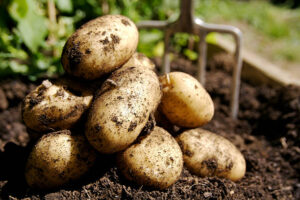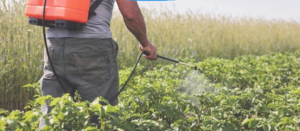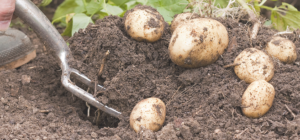Potato Farming In India: The potato is one of the most important and widely consumed foods in the world. A South American vegetable, it is now grown throughout the world. Solanum tuberosum L is the scientific name for this super vegetable, which is known as the “king of vegetables”. Among poor men, it is considered an economical food. There are many people in India who consume this delicious food that has a unique identity. Therefore, it is highly sought after by the Indian population. Over 300 years of potato farming have been carried out in the nation because of this reason. Due to this, it is the fourth most important food crop after rice, wheat, and maize.
There are 23 states in India that cultivate it. The states of Uttar Pradesh, West Bengal, Bihar, Punjab, and Gujarat produce the most potatoes in India. The best growing season for potatoes is between mid-June and mid-July, followed by October and November.
It is a member of the nightshade family, Solanaceae, and is considered to be the most significant food crop in the world. Their high starch content, vitamins, especially C and B1, and minerals make them a very good source of nutrition. In addition to providing low-cost energy, they also provide a source of essential nutrients. In addition to starch and alcohol production, potatoes are used for a variety of industrial purposes. The starch from potatoes (Farina) is used to shape yarn in textile mills and in clothing. Glucose and dextrin are also produced by potatoes. Food products made from potatoes include potato chips, sliced potatoes, and sliced potatoes.
Potatoes are cultivated in India
Potatoes are grown in large quantities in India, since most people choose to cultivate them. The cultivation of potatoes is one of the best sources of good income. The program contributes to the success of farming businesses and the achievement of high incomes. This blog will provide you with complete information about potato farming if you are a beginner or have little knowledge about it. The following blog is a step-by-step guide to growing potatoes. You can do potato crop farming in India with the help of the following potato crop farming guides.
Visit this blog to learn how potato cultivation is done. In one place you will find the answers to questions about growing potatoes, planting potatoes, cultivating potatoes, etc.
Planting Potatoes: Soil & Climate Requirements

The potato grows well in well-drained soil, but it hates wet soil. Potatoes can grow in most soil types except for saline and alkaline soils. The least resistant soil for tuber expansion is naturally loose soil. The best soil for growing potato plants is sandy loam and loamy soil rich in organic matter with good drainage and aeration. It is best to grow potatoes in soil that has a pH of 5.2-6.4. Temperatures of 24°C are best for growing potatoes while temperatures of 20°C are best for growing tubers. Potatoes are therefore classified as cool-weather crops. Harvesting potatoes at 14-20°C is ideal. Potato cultivation requires soil that is well drained and productive.
Land Preparation For Potato
In order to plough the field, well-pulverized beds should be ploughed 20-25 cm deep. Two or three times should be harrowed after plowing. One or two planking operations should level the soil. Before sowing, ensure that the soil has enough moisture.
Read More:The top 10 brush cutters in India: Types, uses, and advantages
Timing of potato planting or sowing

During the growing season, potatoes are only produced under slightly cooler conditions. As a result, the best time to sow potatoes in India varies from region to region. The spring crop in Himachal Pradesh and Uttar Pradesh is sown in January-February, while the summer crop is sown in May. The spring crop is planted in Haryana, Punjab, Uttar Pradesh, Bihar and West Bengal in January, while the main crop is planted in October. Kharif crops are suppressed in Madhya Pradesh, Maharashtra, and Karnataka by the end of June, whereas Rabi crops are planted mid-October to mid-November.
How To Grow a Potato Plant?
During the early spring of last year, seed potatoes were planted by frost. You should cut potato pieces for planting 1-2 days in advance. In addition to preventing rot, this process also retains moisture. Be sure to spread and mix organic compost or rotted manure in the trench before planting. Plant potato seeds four inches apart in a trench one foot deep.
The best way to grow potatoes is in rows. You should dig a trench 6-8 inches deep and plant each potato every 12-15 inches, spaced 3 feet apart. If you are growing baby potatoes or have a small space, you can decrease the spacing between plants. Let the plants grow and continue to fill the trench. The soil should be mounded around the plants as they grow. Make sure to cultivate the soil once more before planting. As a result of this process, the potato plant will be able to establish more rapidly, since the weeds will be removed and the soil will be loosened.
Read More: The 9 Best Rural Marketing Strategies In India
Potato Agriculture Requires Irrigation

In the summer, keep the potato vines well watered, especially during flowering stages and immediately after flowering. This will help the potato crop to grow well. Flowering is the time when plants form their tubers, so a steady supply of water is essential. It is best to water potatoes regularly as they need constant moisture. Approximately 1-2 inches of water or rain per week is sufficient for potato production. Leaves should be stopped being watered once they turn yellow and begin to die back. Potatoes will be able to start healing for harvest if they are treated this way. The use of drip irrigation increases potato yields for potato farmers.
Crop Rotation for Potato Farming

The rotation of crops is an essential step for the good growth of crops. In the same way, don’t plant potatoes in the same field every year. Thus, proper crop rotation increases soil fertility, reduces specific pest problems, conserves soil moisture, enhances soil structure, and increases soil organic matter.
Here is the cropping rotation.
-
Potato-Wheat-Maize, Potato-Wheat-Paddy, Potato-Wheat-Green manure crop in Punjab
-
(Transplanted) Potato-Mung-Paddy in Assam
-
The Bihar Potato-Mung-Paddy; the Potato-Mung-Groundnut
-
Potatoes, okra, and soybeans in Madhya Pradesh
-
UP & Gujarat: Potato, Bajra, Groundnut
Plantation care and pest control

These pests are dangerous to potatoes, such as aphids, flea beetles, leafhoppers, early/late blight, potato scab. They are most likely caused by soil with high pH levels. Potatoes grow best in acidic soil (never plant potatoes in soil with a pH higher than 5.2). Make sure seed potatoes are dusted with sulfur before planting.
Read More: A buffalo dairy farm Project Report: Costs and Profits
Fertilizers & Manure for Potato Cultivation

The amount of chemical fertilizer required depends on the level of soil nutrients. For example, volcanic soils have low levels of phosphorus, while the amount of fertilizer required by irrigated commercial production is relatively high. In addition, organic fertilizer can provide a good nutrient balance and maintain soil structure at the start of a new rotation. In order to estimate fertilizer requirements for a crop accurately, it is necessary to consider the expected yield of the crop, its potential, and its use.
It is best to use a composted or aged manure for potato cultivation in India if there is access to animal manures. To give soil microbes time to break down compost before planting, add compost in the fall. With a plough and shovel or rotary tiller-hoe, fold the manure into the top 6-8 inches of soil after spreading it over the garden.
Process of harvesting potatoes

-
When to harvest potato depends on the soil type, the area of sowing, and the variety. Harvesting should take place 75-120 days after planting.
-
It is generally best to harvest a hillside crop when the soil is not too wet.
-
Gently dig around the plants to remove potatoes for fresh eating, while taking care not to damage the plants.
-
You should try to remove the bigger new potatoes and leave the smaller ones to continue growing.
-
Harvest potatoes when the leaves turn yellow and dry.
-
Crops can be slightly harvested if there is a high market demand for them.
-
If the soil becomes dry before harvesting, do irrigation before harvesting.
-
Plants should be cut 8 days before harvesting at ground level. Potato diggers or ploughs are used for this.
Potato farming in India can be done using these methods of potato cultivation. These methods can help you earn a high income if you plan to start a potato farming business. Visit Aarug Agro to learn more about implements for potato crop cultivation in India. A potato farming machine, potato cultivation techniques, and many other topics can be found here.


